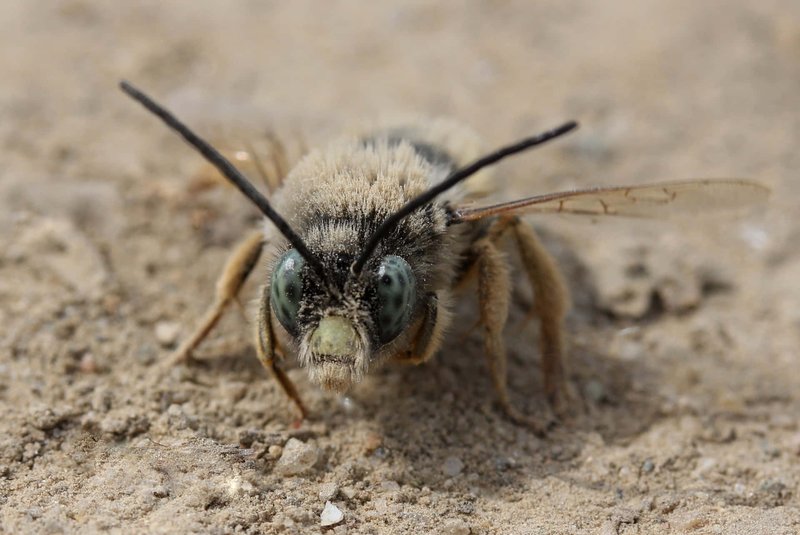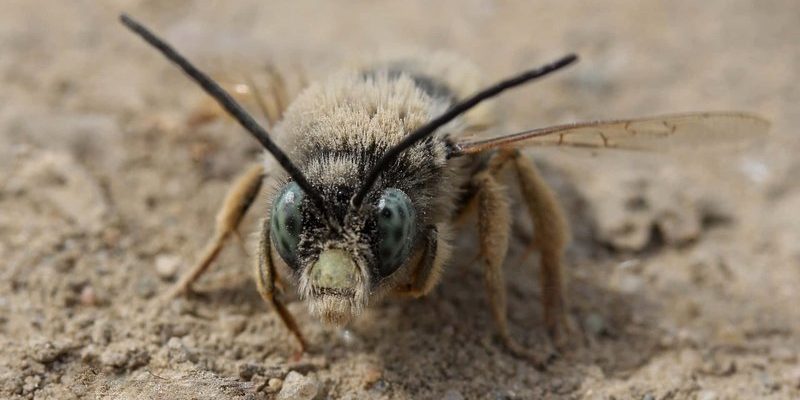
Let’s dive into some of these myths, clear the air, and shine a light on what makes mining bees so special. You might be surprised by what you learn!
Myth 1: All Bees Make Honey
You might assume that all bees are in the honey-making business, but that’s not the case. Mining bees, unlike honeybees, don’t produce honey. They prefer to keep things simple. Instead of building elaborate hives, they dig individual nests in the ground.
Mining bees spend most of their time foraging for pollen and nectar, which they use to feed their young. Think of them as independent artists working on their solo exhibitions rather than part of a massive choir. Each mining bee’s nest is often a small chamber in which she lays her eggs and provides a food source. So while honeybees are busy creating sticky treats in their hives, mining bees are content living a quiet life underground.
Myth 2: Mining Bees Are Dangerous
It’s common to fear that anything that buzzes might sting. However, mining bees are generally non-aggressive and pose little threat to humans. If you encounter one, it’s likely going about its business, focused on finding food.
Here’s the thing: mining bees have no interest in attacking you. They’d much rather avoid confrontation. If they feel threatened, they might buzz away rather than sting. So, if you happen upon one while gardening or enjoying the outdoors, just give it some space.
The Anatomy of a Mining Bee
Let’s talk about why mining bees aren’t as intimidating as they might sound. These bees are smaller than honeybees, often measuring only about a half-inch long. They’re typically covered in fine hairs that help them gather pollen. This adaptation makes them excellent pollinators, which is crucial for flowers and crops alike.
Instead of aggression, mining bees exhibit fascinating behaviors. They’re often seen hovering over flowers, and they quickly dart from one bloom to another, collecting pollen.
Myth 3: Mining Bees Are Rare
You might think that mining bees are hard to find, but they’re more common than you’d expect. In fact, there are over 600 species of mining bees in North America alone! While some species might be less visible because of their solitary nature, they exist all around us.
Many of these bees can blend easily into the environment, making them less noticeable. Their nests are often hidden underground, so you might not even know they’re nearby. When you start to look closely at wildflowers in your garden, you might just catch a glimpse of these industrious little workers.
Where to Find Mining Bees
If you’re looking to spot mining bees, consider planting native flowers in your garden. These bees are drawn to a variety of blooms, including dandelions and clover. The next time you see a flower patch buzzing with activity, it might just be a mining bee hard at work.
You don’t have to venture into the wild to find them. Start with your backyard, and you might be surprised to see how many are buzzing about.
Myth 4: Mining Bees Don’t Pollinate
You might be wondering if mining bees contribute to pollination. Spoiler alert: they absolutely do! These little garden helpers are crucial for many plants’ reproductive cycles.
When mining bees visit flowers to collect nectar and pollen, they facilitate pollination. As they flit from bloom to bloom, they transfer pollen, which helps flowers produce fruits and seeds. This action is essential for maintaining biodiversity and supporting ecosystems.
The Impact of Mining Bees on Agriculture
Think about it—without effective pollinators like mining bees, we’d see a decline in crop yields. This can affect everything from fruit trees to vegetable gardens. Many farmers depend on these little bees to help their crops flourish.
If you’re a gardener, encouraging mining bees can lead to a healthier and more vibrant garden. By planting a variety of flowers, you can attract these beneficial insects and boost your garden’s productivity.
Myth 5: Mining Bees Are Nocturnal
Have you ever heard that mining bees are active at night? It’s time to debunk this myth! Mining bees are diurnal, meaning they do their foraging during the day when the sun is shining.
In fact, you’ll typically spot them flitting around flowers in the early morning to late afternoon. This is when they’re most active, taking advantage of the warm sun to gather food for themselves and their young.
The Best Time to Observe Mining Bees
If you’re an aspiring bee-watcher, plan your observations during the day. Early spring or early summer is an excellent time to see mining bees in action. You might enjoy a cup of coffee in the garden, watching them busily collect nectar while you soak up the sun.
Letting nature unfold before your eyes can be a delightful way to connect with these important pollinators.
Why Understanding Mining Bees Matters
Now that we’ve cleared up a few myths, you might wonder why it’s essential to understand and appreciate mining bees. To put it simply, these little creatures are vital for our environment and food production.
By learning about mining bees and their roles, we can foster a greater appreciation for biodiversity. Understanding their importance can inspire us to create more pollinator-friendly spaces in our gardens.
As we become more aware of our local ecosystems, we can help protect these important insects. Every small action, like planting native flowers or reducing pesticide use, can make a big difference.
In conclusion, mining bees are fascinating little creatures that play a significant role in our ecosystem. They may not make honey or live in hives, but their pollination efforts are indispensable. By debunking common myths, we can foster a deeper appreciation for these solitary yet incredibly valuable bees. So the next time you spot a mining bee in your garden, take a moment to admire its hard work and contribution to our world. Let’s work together to protect and celebrate these incredible pollinators!

